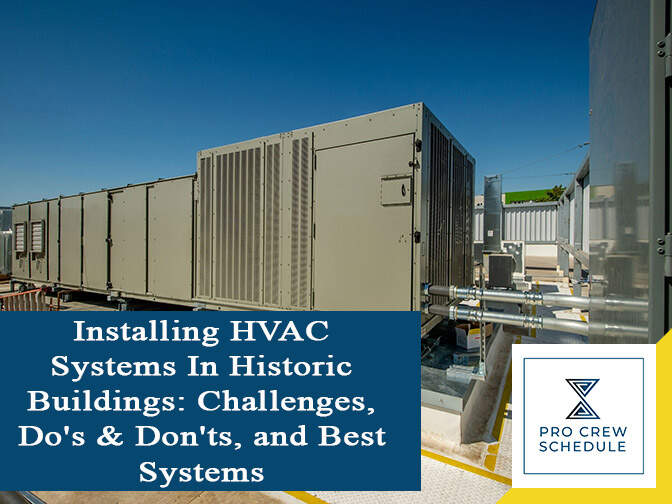Many old and historical buildings are still standing among the thousands of new buildings currently under construction, a lot of which were made with a construction schedule software. Instead of taking them down to make way for more recent structures, many organizations are decided to preserve them. But because these old buildings are not equipped with modern conveniences and comforts, such as artificial heating and cooling, they are being retrofitted by professional contractors with useful project management tools.
However, centuries of exposure have worn and torn them, making these buildings delicate and fragile, requiring the utmost care and gentleness when modified. Additionally, these buildings were not built to house today’s technology. As new mechanical and electrical systems can use around 10% of the building’s square footage, meticulous planning and a subcontractor scheduling software are needed to avoid any damage to the structure.
Primarily, these system upgrades in historic buildings are a result of the want to improve energy efficiency. Unfortunately, the occupants’ comfort also is a factor in which contractors prioritize that above building preservation. That’s why these types of projects would require highly qualified contractors and the very best construction management software to aid in careful planning to balance indoor comfort with the preservation objectives. If that balance is not taken into account, several problems might ensue that could damage. With accurate plans, skilled hands, and the assistance of an organized builder schedule, project managers and crew members can prevent these problems.
Challenges With HVAC Systems For Historic Buildings
1. The preservation objectives
As HVAC installers, their main goal is to fit an efficient and stable system that not only meets the comfort needs of the building’s occupants but also retaining much of the structure’s fixtures, features, and appearance. The challenge here balancing these two factors. Often, contractors prioritize the system’s efficiency and interior comfort over the building’s preservation objectives– this can lead to other problems like:
● Removing large sections to make room for the systems;
● Accidentally introducing moisture that can damage the historic features;
● Altering the interior for grilles, registers, dropped ceilings, and other modern features;
● Accidentally weakening the structure due to the addition of weight and vibrations from the large equipment; and
● Stripping and replacing finishes and cladding to put in in new vapor or insulation barriers.
Installing HVAC systems in historic buildings is not as simple as installing them in ones currently under construction. In addition to balancing comfort and preservation, HVAC installers will not be working on a skeletal structure where they can make all the necessary changes with little to no problems. Instead, they face the challenge of fitting these systems in already existing buildings. This goes back to the preservation objectives– they strictly have to adhere to them, making it difficult to make alterations to cater to the HVAC systems’ installment.
2. Finding the right system for the building
True for all structures, there is no one perfect system for all situations because they are built differently. What makes it extra tricky for historic buildings is its unique and old structure from modern ones, which most HVAC systems are made for.
To find the right system, the building’s purpose must first be determined. If it is to be a museum, particular climate control systems will be needed to preserve the artifacts; alternatively, if the building will be used commercially or residential, alterations and details maybe a little more lenient. The important thing is to complete the job with minimal impact successfully.
Afterward, during the design phase, the interior temperatures and humidity levels must regularly be monitored to complete the structure’s assessment. In addition to that, there are other factors to consider to maximize energy efficiency and preserve the building.
● Areas where energy efficiency is high to allow a, reduces the size of equipment;
● Location and equipment problems that need to be resolved before installation;
● Any features, such as mechanical systems, grilles, and radiators that can be reused;
● Local building and fire codes;
● Where all cooling towers, air handlers, and chillers are located;
● Condition and location of existing mechanical systems and construction materials; and
● Features, areas, and finishes that must be preserved.
Moreover, weighing out the pros and cons of the different systems will help decide which is the best for the building.
Like hydronic radiators, water systems have smaller pipes than forced air ducts, making it easier to install while not damaging prominent features and can often be restored. However, these can run the risk of leaks and burst pipes that can introduce moisture and damage fixtures and surrounding areas.
On the other hand, central air systems offer climate control, answering the ultimate goal of catering to the occupants’ comfort indoors. Plus, with many of the having condensers outside, the equipment will affect building space minimally. The drawback, however, is the possibility of severe damage to the building’s appearance during installation.
More often than not, small-duct systems are the best solution. They are easy to install and are less likely to harm surrounding features because of the flexible tubing.
Whatever type of system the building needs, these questions are integral in deciding:
● Is it easy to maintain?
● Does it have humidity monitors and safety systems?
● Can it be upgraded in the future?
● Will it be installed within the building’s structural limitations?
● How much noise and vibrations will it make?
● Is it visually compatible with the original architecture?
3. Forming the team
As retrofitting is a delicate and meticulous job, HVAC systems’ installation will need highly competent and experienced people. These projects would require an HVAC technician, an electrical engineer, a mechanical engineer, a structural engineer, a preservation architect, and preservation consultants who know the building and its importance.
Tips HVAC Systems in Historic Buildings
1.Understand what the building is for
Knowing the purpose of the building will significantly help in determining what kind of system is needed. For example, a restaurant will have different climate control needs than a spa or a museum. Without recognizing what the structure will be used for, it might end up with a too big or too small system, defeating its goal of comfort.
2. Consider traditional cooling methods
A priority in retrofitting is keeping as much of the building as possible. Adding features or utilizing ones already there that aid in traditional cooling methods can significantly less cooling loads, minimizing the new system’s complexity and size. These include awnings, shutters, operable windows, and ceiling fans.
3. Consider the equipment’s weight.
Because old buildings were not designed to carry modern technology and weight, adding extra weight can damage the structure. That’s why meticulous planning is vital for these projects.
4. Add insulation the right way
As insulation is an excellent way for energy efficiency, adding them to walls can be risky without damaging exterior cladding or interior wall finishes. So, it needs to placed carefully.
5. Factor in heights of the ceiling
Some historic buildings have low ceilings that can add ductwork or air handlers hard, while others have high ceilings that are beautiful and must be preserved. If the ceiling is out of the option, look for other air distribution systems, like existing shafts or even closet space.
6. Try to reuse existing HVAC elements.
Taking advantage of existing HVAC equipment in the building has multiple benefits.
For one, elements like radiators and grille covers are part of the building’s charm, and embracing them would only enhance that. Another is utilizing equipment that is already there can help in cost-cutting for the renovation.
You can still add modern features while retaining old-fashion elements.
7. Have easy access to equipment
This measure is to ensure easy maintenance. For historic buildings, it’s essential to maintain properly.
8. Plan for humidity control
Humidity control is especially important in historic buildings. Neglecting this can aid in the deterioration of old masonry, wood, plasters, and fabrics.
In addition to what should be done, here is a list of what should be avoided in installing HVAC systems in historic structures:
● Install a new system unless it’s needed
● Forget modern solutions
● Cut through exterior walls
● Don’t alter or modify historic architecture
● Don’t make the system an eyesore
● Introduce moisture
● Neglect maintenance
HVAC Systems for Historic Buildings
As aforementioned, small-duct systems are considered the better choice for HVAC installations in historical buildings. Here are some viable options for historic systems that use a small-duct high-velocity system (SDHV).
1.The Unico System
The central air system by The Unico System uses quiet jets to distribute conditioned air. Aside from making minimal noise, the SDHV eliminates the need for conventional ductwork, making it perfect for historic structures.
2. SpacePak
Also using SDHV, the system by SpacePak does not require existing ductwork, very suitable for historic buildings. This system makes use of 5-inch outlets and 2-inch insulated flexible tubing. With that, they can easily be threaded in floors, ceilings, and walls, leaving no disruption in living spaces.
3. Blue Duct
Finally, Blue Duct is an SDHV system that’s installed on the floors. Designed to provide heating, cooling, and ventilation that cannot be seen nor heard, the Blue Duct is highly recommended and appropriate for historic buildings.







